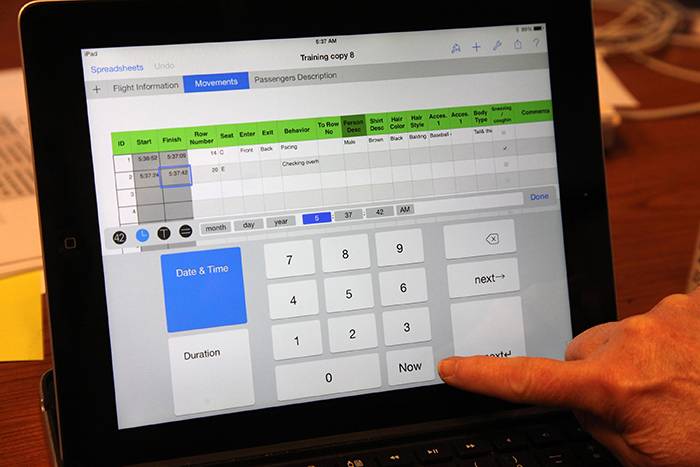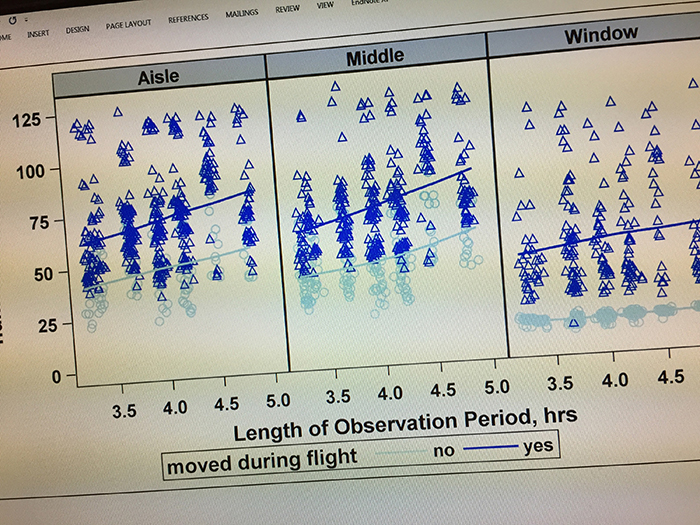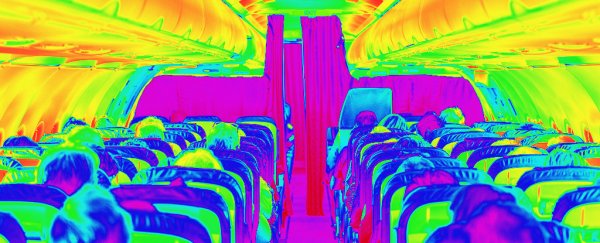If you often find yourself coming down with a cold after taking a flight, take note: by mapping the spread of a virus through an aeroplane cabin, researchers have found that your chances of getting the sniffles largely depend on how much you move about.
Based on influenza models, the new study shows you have an 80 percent chance of getting the flu off someone if you're sitting in the row in front or the row behind, or within two seats to either side. Otherwise, your chance of infection drops all the way down to 3 percent.
But… that's assuming you stay still. Move around the cabin, and you're more likely to come into contact with a passenger or a crew member suffering from a cold. The advice seems to be, if you want to stay well by the end of your trip, try and limit the amount of walking around you do while up in the air.
 Passenger movements were tracked on an iPad. (Emory University)
Passenger movements were tracked on an iPad. (Emory University)
"We found that direct disease transmission outside of the 1 metre [3.2 feet] area of an infected passenger is unlikely," says one of the team, mathematician Howard Weiss from the Georgia Institute of Technology.
Very little research has actually looked at this question before. In this case, a team of 10 people flew on a total of 10 different transcontinental flights, armed with iPads to make observations about passenger and crew movements.
They backed up their observations by taking 229 samples from the air and surfaces on board the planes, looking for traces of 18 common respiratory viruses.
There's one important limitation we should talk about: the researchers didn't actually track the spread of flu or any other virus. Instead, they tracked passenger and crew movement, and then applied existing models of how flu spreads to this data.
 One of the passenger tracking charts. (Georgia Tech)
One of the passenger tracking charts. (Georgia Tech)
"The simulations provide compelling evidence that for influenza, if you are not seated within a metre of an infected passenger, and you practice careful hand hygiene, then you are unlikely to get infected during flight," Weiss told George Dvorsky at Gizmodo.
That was backed up by those 229 samples – not a fully comprehensive sweep of the planes, of course, but nevertheless there were no traces of bugs in any of them.
The research showed that around 40 percent of passengers never get up on these shorter, transcontinental flights. Another 40 percent get up at least once, and 20 percent get up two or more times.
You're more than twice as likely to get up if you're sat in the aisle than when you're sat by the window, the study suggests. Meanwhile, the average time passengers spend away from their seats is 5 minutes.
A wandering member of the cabin crew can infect an average of 4.6 passengers on a flight, the research model also showed – so whether you're working or travelling on a plane, it's best to stay home if you're ill.
As we've said, the research uses models of flu patterns rather than actually tracking the spread of bugs around a cabin, and the observations were also restricted to focus on shorter flights of up to 5 hours.
Those shorter flights mean smaller, single-aisle planes as well – and we already know they're better at limiting the spread of infection.
All that said, this is still a useful and pretty rare look at the way sickness can make its way around an aeroplane, and particularly our movement habits.
We definitely need to understand more about why people get sick when they travel, and how those colds and coughs can spread, according to molecular biologist Edsel Maurice Salvaña, from the University of the Philippines Manila, who wasn't involved in the study.
"The study team did a good job with mapping patient movements and going the extra step of testing for a panel of 18 respiratory viruses using highly sensitive nucleic acid testing," Salvaña told Gizmodo.
So why is it that so many of us seem to pick up bugs when we're on flights – is it just our imagination, or is there really an uptick in illness for travellers? Infections could be caught at the airport, suggest the researchers behind the study, or on other, longer connecting flights.
More detailed studies are going to be required before we can work out what's really going on, but in the meantime your chances of getting a bug may not be as high as you thought – and you can minimise the risk by washing your hands, which protects against indirect transmission.
"Passengers and flight crews can eliminate this risk of indirect transmission by exercising hand hygiene and keeping their hands away from their nose and eyes," says Weiss.
The research has been published in PNAS.
